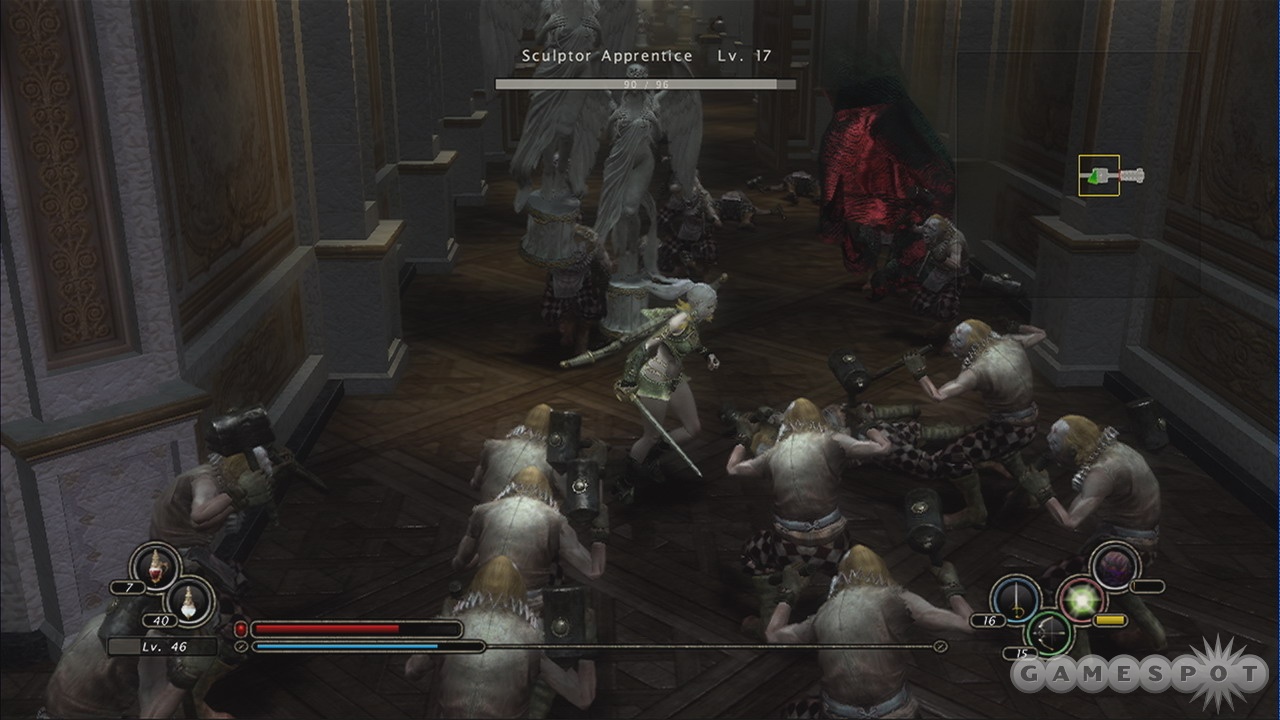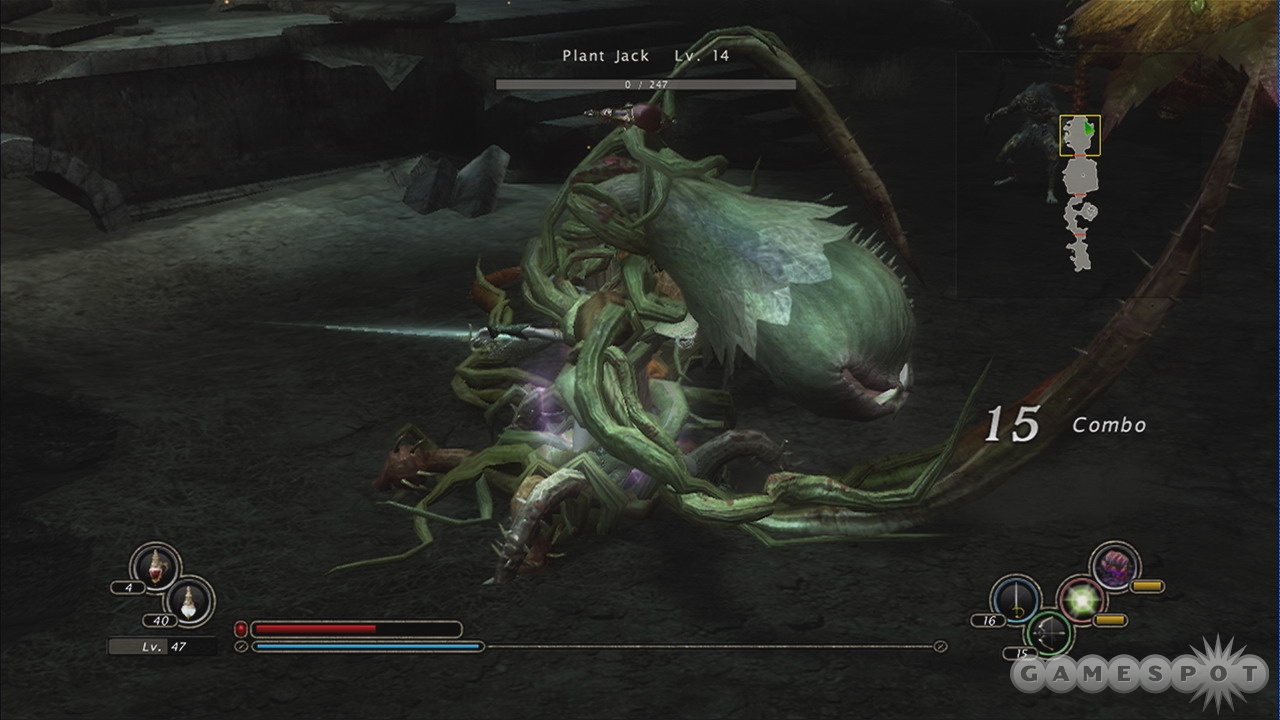The Kingdom Under Fire series experienced a renaissance with the release of the excellent Crusaders on the Xbox in 2004, and Circle of Doom takes even more chances with the franchise. Unlike its predecessors, though, the game eschews strategy elements in favor of a pure action role-playing experience, albeit with uneven results. The action devolves into tedium, the story has no obvious bearing on the gameplay proper, and a number of unnecessary hindrances break up the rhythm of the gameplay. If you take things online with friends, the pace picks up, but not enough to overlook some noticeable and annoying drawbacks.
Like much of Circle of Doom, the story guns for sophistication but ends up being relatively inconsequential, simply because there's no strong narrative thread to tie the action together. You'll start the game controlling one of five characters that fall into the usual hack-and-slash archetypes (a sixth can also be unlocked), and each experiences a slightly different story, though the manner of storytelling is the same for all of them. Within dungeons, you will find idols (which also function as vendors and, occasionally, quest givers) that provide a safe place for sleeping and dreaming. Once asleep, you enter a dreamworld where you can talk with characters that provide quests and serve up bits of cryptic dialogue that may lead fans of previous Kingdom Under Fire games to nod their heads with understanding, but will confuse most anyone else. There are no cutscenes within the gameplay proper, and none of the action seemingly relates to the tale that so slowly and quixotically unfolds in the reveries of sleep. The resulting disconnection between the game and its fragmented parables keeps you from getting engaged, because you're never quite sure why, exactly, you need to be fighting legions of skeletons and lava monsters.
Luckily, you'll hack and slash your way through crowds of far more enticing enemies than those action-RPG standards. Circle of Doom has no shortage of monsters, often tossing many dozens of them at you at a given time. Many of the enemy designs are remarkably imaginative. Grunting, crawling zombies called flesh men swarm around you; invisible lizardmen will attack you without warning; and giant statues and their sculptors clog passageways, waiting for your sword and bow to wreak havoc. When the game is running on all cylinders, slicing your way through the hordes is as compelling as you would expect from the genre--not because the game is anything special, but because the formula on which it's based is a proven one.
In fact, the same formula that provides the majority of the game's entertaining moments is what ultimately drags Circle of Doom down--at times because the game is nothing but formula, and at others because the basic ingredients of the familiar recipe lack depth and refinement. Even with a good number of melee and ranged weaponry, the action gets incredibly repetitive, particularly because to accomplish certain quests and get the most out of the magic system (more on this subject later), you'll revisit the same six dungeons over and over again. One quest that required us to collect pure gold called for multiple visits to the same area, while another forced us to randomly fight through dungeons until the quest giver felt enough time had elapsed. While some of the dungeon aspects generate randomly, the basic elements of the dungeons rarely change, and as creative as some of the monster designs are, it gets tiring to mash your button through the same ones ad nauseam. To make things even more monotonous, while dungeons are broken up into multiple levels separated by loading times, should you need to return to one, you have to fight your way through the entire dungeon, since the game won't let you travel directly to the level you need to visit.
The pacing problems brought about by the vague, disengaged story and constant repetition are further exacerbated by other issues that break up any forward momentum you'll begin to feel. While many enemies don't seem to be trying very hard to strike you, their attacks will frequently (if not usually) knock you back, stun you, or cause a confusion effect that inverts your control scheme until the effect has worn off. At times, particularly in the frustratingly confined dungeon called the Hall of Arrogance, these effects can string together into a horrible, infuriating cycle of inescapable damage, as stone statues knock you down or stun you while drillers spew fire at you and hovering spirits electrocute you. It also doesn't help that the environments, as interesting as some of them look, are constricted and highly linear, which is at odds with the huge number of fiendish foes that rush you. The aforementioned "damage loop" wouldn't be an issue if there were room to move about, but it's relatively easy to be cornered. Additionally, if you string together a number of combo attacks, your character will have to finish a long animation sequence that you can't escape from. The result of these and other prevalent issues give the action a halting and awkward feel that never hits the smooth, quick stride that exemplifies the best games of the genre.
The game's inexcusably jittery camera is also a guilty accomplice to these crimes, because it never seems to know how to arrange itself. Its usual position is a little awkward, since it feels too low to the ground and too close to your character, but it's workable provided there is enough room to move. Alas, the cramped levels confuse the camera, causing it to get stuck behind every object it can find, change angles at inopportune times, or even zoom in so close, all you can see is a jumble of geometry. The camera has been an issue in the prior strategy-action games in the series, so it's disheartening to see that the camera control here is actually a step backward.
You can also perform special attacks, though the method of earning them is certainly an interesting and unusual one. When you visit the dreamworld, you can take quests that open up new skills to you when completed. Learning a new skill or spell generally involves killing a certain number of particular monsters, at which point you can turn in the quest and add the spell to your repertoire. The system sounds nifty, but in actuality, it's highly problematic. Until you choose which spell you want to acquire, you aren't even sure what monsters you will need to defeat, so you can't choose missions that fit in with your current main quest progress. In some cases, it means returning to a dungeon you've already slogged through a number of times, while in others, you may need to visit an area you haven't been to yet. In the end, earning new spells can often be more trouble than it's worth, and many of them are so ineffective, it's not worth the extra 30 minutes of repeated dungeon-crawling it takes to earn them. Furthermore, you can take on only two skill quests at a time, which means you may go many hours without learning a single skill at all. It simply isn't worth it, unless you have returned to the game to play on a higher difficulty level. On the standard difficulty, however, you could reasonably play the entire game without ever needing a single special skill at all.
Outside of the action proper, there are some interesting ideas at play, but again, they sound cleverer on paper than they are in practice. When you level up, you can spend attribute points in one of three areas: hit points, skill points, and luck. Hit points are the only straightforward aspect of the three, and spending points in this area increases the size of your health bar. Skill points contribute to your stamina bar, which is possibly the game's most interesting feature. In Circle of Doom, just the act of swinging or firing your weapon diminishes your stamina bar, and each weapon diminishes it in various degrees. It's fairly quick to fill up, but a weapon that uses a lot of stamina will deplete the bar relatively quickly, which means you need to either wait for enough stamina to swing again, or use a white potion to completely replenish your meter. It's another aspect of the action that can often contribute to even more awkward pacing--but it's also relatively strategic, because you can't just rely on the speed and attack prowess of the weapon to determine how effective it will be in battle. A relatively weak weapon that doesn't deplete your stamina can actually be more effective than a stronger weapon that diminishes it quickly, because you can't swing it continuously and will need to frequently wait for your stamina to recharge.
Luck is the third attribute on which you can spend points, though it is the vaguest of the three. According to the game manual, spending points in luck increases the frequency and quality of item drops, and we can certainly attest to finding better loot after spending attribute points in that area. Luck also increases your chances of success at synthesis. You can enhance weapons, armor, and accessories by visiting an idol and using an item and/or special ability to increase their effectiveness. The result isn't always an improvement, and guaranteeing 100 percent success on the synthesis attempt can be tough on your in-game wallet, but it's a perfectly reasonable method of item enhancement that benefits from some trial and error.
Circle of Doom can be played offline, or you can join up to three other others cooperatively; and like many similar games, the gameplay benefits from the addition of others. This is most apparent with some of the wearisome, often torturous boss characters, which aren't all that challenging but are certainly time consuming if you're on your own. Because some of them are obviously tailored toward certain characters over others (the first boss, which requires a ranged weapon, is an obvious example), a well-rounded party of four can increase the entertainment value significantly. Sadly, co-op play isn't available offline, so you'll need to play online via Xbox Live to use this feature. We didn't any experience any major lag or other glitches, so you should expect online play to be a relatively problem-free experience.
There is some occasional eye candy to check out, and Circle of Doom's art direction is consistently attractive, if not exactly stupendous. This isn't as obvious in some dungeons as in others--after all, ice caverns can only be so interesting. However, some levels are nice to look at, featuring colorful foliage, appropriately arid-looking deserts, and library corridors filled with bookcases and wardrobes. The game engine isn't a technical powerhouse, and you'll notice plenty of pop-in and a few frame rate jitters here and there. Yet slaughtering your enemies results in a nice spattering of blood and some nice, subtle visual effects. The sound design is also subtle, but to a fault. Many sound effects are oddly muted, while the soundtrack mixes orchestral swoons with metal grinding for varied but forgettable results.
In short spurts, Kingdom Under Fire: Circle of Doom can be reasonably amusing, though even the most resolute hack-and-slash enthusiasts will likely grow tired of the nebulous story and monotonous battles before reaching the final boss. Considering the number of character-specific quests and multiple story threads, the campaign is obviously meant to benefit from multiple play-throughs. The problem is that the actual act of playing it isn't very rewarding, so while there are some good ideas at work, these erudite ideas are overshadowed by a good number of design flaws that keep Circle of Doom from delivering any dependable sense of fun.


